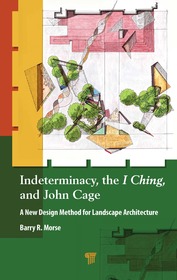
Indeterminacy, the I Ching, and John Cage
A New Design Method for Landscape Architecture
-
10% KEDVEZMÉNY?
- A kedvezmény csak az 'Értesítés a kedvenc témákról' hírlevelünk címzettjeinek rendeléseire érvényes.
- Kiadói listaár GBP 37.99
-
18 149 Ft (17 285 Ft + 5% áfa)
Az ár azért becsült, mert a rendelés pillanatában nem lehet pontosan tudni, hogy a beérkezéskor milyen lesz a forint árfolyama az adott termék eredeti devizájához képest. Ha a forint romlana, kissé többet, ha javulna, kissé kevesebbet kell majd fizetnie.
- Kedvezmény(ek) 10% (cc. 1 815 Ft off)
- Kedvezményes ár 16 334 Ft (15 557 Ft + 5% áfa)
Iratkozzon fel most és részesüljön kedvezőbb árainkból!
Feliratkozom
18 149 Ft

Beszerezhetőség
Még nem jelent meg, de rendelhető. A megjelenéstől számított néhány héten belül megérkezik.
Why don't you give exact delivery time?
A beszerzés időigényét az eddigi tapasztalatokra alapozva adjuk meg. Azért becsült, mert a terméket külföldről hozzuk be, így a kiadó kiszolgálásának pillanatnyi gyorsaságától is függ. A megadottnál gyorsabb és lassabb szállítás is elképzelhető, de mindent megteszünk, hogy Ön a lehető leghamarabb jusson hozzá a termékhez.
A termék adatai:
- Kiadás sorszáma 1
- Kiadó Jenny Stanford Publishing
- Megjelenés dátuma 2025. december 2.
- ISBN 9789815129885
- Kötéstípus Keménykötés
- Terjedelem218 oldal
- Méret 229x152 mm
- Nyelv angol
- Illusztrációk 19 Illustrations, black & white; 45 Illustrations, color; 10 Halftones, black & white; 29 Halftones, color; 9 Line drawings, black & white; 16 Line drawings, color; 21 Tables, black & white 700
Kategóriák
Rövid leírás:
This book addresses the questions of how one might approach using this method in landscape architectural design, what the outcome of such an indeterminate design would be, and whether or not it could lead to a viable constructed landscape.
TöbbHosszú leírás:
The creative use of indeterminacy, that is, “chance,” is an often-overlooked design opportunity despite the universality of chance in art, nature, science, and life. How can “chance,” a seemingly capricious phenomenon, be made to work for someone? One controlled use of chance is through the Chinese I Ching “chance operations” method of composer and artist John Cage (1912–1992). This book addresses the questions of how one might approach using this method in landscape architectural design, what the outcome of such an indeterminate design would be, and whether or not it could lead to a viable constructed landscape.
In addition, this book answers the question: What is the relationship between the I Ching, John Cage, and the constructed landscape anyway? The final product of the exploration of this method is a new hypothetical redesign of an existing plaza using Cage’s techniques and a comparative evaluation of the new indeterminate concept and the two pre-existing designs, using the original program objectives as a guide against which the three designs can be judged for effectiveness.
TöbbTartalomjegyzék:
Introduction PART I THE FOUNDATIONS OF INDETERMINACY 1. Man and the Landscape 2. The Origins of Indeterminacy PART II A SPECIFIC MODEL FOR DESIGN: JOHN CAGE’S APPROACH TO INDETERMINACY 3. A Short Biography of John Cage (1912–1992) 4. Cage’s Attitudes Regarding Indeterminacy 5. Cage’s Use of Chance Operations in Music 6. Cage’s Use of Chance Operations in Visual Art PART III: APPLICATION OF INDETERMINACY TO A SPECIFIC LANDSCAPE 7. The University of Arizona Alumni Plaza: Two Deterministic Designs 8. The University of Arizona Plaza: A New Indeterminate Design 9. A Comparative Analysis of the Three Designs Appendix A: Equivalency Tables Appendix B: Hexagram Cast Tables Appendix C: Miscellaneous Charts Appendix D: Materials Charts Appendix E: Comparative Evaluation Chart Appendix F: Design Process Statistics Appendix G: Additional Images Appendix H: Other Modes of Indeterminacy
Több



